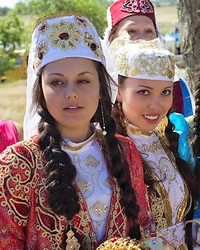Throughout history, Armenia has been a battlefield for many invaders and contending empires, and a bridge for many cultures and civilizations. During the past 2,700 years, Armenia has been conquered by the Persian Empire, Alexander the Great, the Roman Empire, the Byzantines, Arabs, Mongols, Tatars, Ottomans, Persians, and Russians. Armenian kingdoms, principalities, and even a short-lived empire (95-55 B.C.) managed to survive and thrive for some 1,700 years. Under various kings and princes, the Armenians developed a sophisticated culture, an original architecture, and their own alphabet.
The 1905 Russian revolution and the 1908 Young Turk revolution raised the hopes of the Armenians for reform, and an opportunity to build a homeland in historical Armenia. These hopes were dashed as the Ottoman and the Russian Empires fought each other during World War I. A dark hour of Armenian history is the Armenian genocide, which started on April 24, 1915. Some 1,750,000 Armenians were deported into Syria and Mesopotamia by the Ottoman authorities. Subject to famine, disease, and systematic massacres, most of them perished. This "ethnic cleansing" of the Armenians from their historical homeland led Raphael Lemkin, the father of the Genocide Treaty, to coin the new term "genocide" in the 1930s to describe the historical plight of the Assyrians and the Armenians as subjects of the first genocide of the 20th century. Armenia gained independence on September 23, 1991.
Today, there are several million Armenians worldwide. Significant numbers are located in Armenia and the United States of America. Major diaspora centers of the Middle East are Iran, Syria and Lebanon. Some live in Spain. A small number of Armenians settled in Spain as early as the 1500s, but most came after the USSR dissolved in 1991. They are most likely to be found in Barcelona, Valencia, and Madrid.
Armenians in Spain often have their own businesses, especially restaurants. Mediterranean food is popular in Spain. They have their own cultural associations where they can associate with other Armenians. There are Armenian churches, that differ from the prominent Roman Catholic ones of Spain.
In 301 AD, during the rule of King Dirtad III, Armenia became the world's first Christian nation. A Christian monk, commonly known as Krikor Lusavorich or St. Gregory the Illuminator, cured the King from a disease. After this event, King Dirtad III was baptized and accepted Christianity as Armenia's official state religion. Before this, two disciples had brought Christianity to Armenia, St. Thaddeus and St. Bartholemew. Today, Armenia is still a Christian nation, comprising: Armenian Apostolic Orthodox (the overwhelming majority), other Christian (a small percentage) and Yezidi (Zoroastrian/animist, very small percentage) of the population.
Armenians need the Holy Spirit to move in their families and their churches so they can enjoy the abundant life that only Jesus offers.
Pray for the Armenians in Spain to be salt and light to those who don't know the only Savior.
Pray for spiritual peace; this is what Armenia needs most of all.
Pray that God would bring revelation of Christianity as a spiritual relationship, and that Armenians would realize they can have joy and peace as they follow the Lord.
Pray for their businesses to flourish as a testimony of God's power and goodness.
Scripture Prayers for the Armenian in Spain.
Middle East Resources
https://en.wikipedia.org/wiki/Armenians_in_Spain
https://mirrorspectator.com/2025/05/15/the-many-faces-of-the-spanish-armenian-community/
| Profile Source: Joshua Project |












